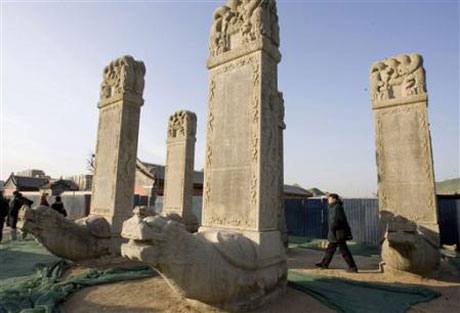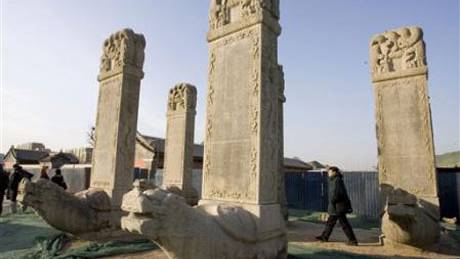Beijing Unveils Centuries-Old Temples
Source: redorbit.com

Amid its frenzied citywide makeover for the 2008 Olympics, Beijing unveiled two centuries-old temples Friday that were salvaged from decades of neglect and saved from the current construction boom.
The modest temples - one to a fertility goddess, the other to a dragon deity who controls rain and rivers - sit on either end of the Olympic Green, a 1,000-acre expanse that will be the center of the Games and that is now abuzz with construction.
Their rescue is part of a promise China's leaders made in bidding for the Games - that the Olympics would foster historic preservation in an ancient capital that has often neglected the past as it hurtles toward the future.
"Beijing is a city very rich in cultural relics so the construction of venues had to be connected to the protection of relics," Kong Fanzhi, director of the Beijing Cultural Relics Protection Bureau, told reporters as he stood in a courtyard of the partly restored Niang Niang Temple. "Our slogan is to have a 'Cultural Olympics.'"
The slate-gray roof and unpainted wood walls of the Niang Niang Temple, named for a Taoist goddess and built 500 years ago during the Ming Dynasty, seem incongruous next to the ultramodern venues nearby - the giant steel-latticed National Stadium, nicknamed the "Bird's Nest," and the National Aquatics Center, or "Water Cube," covered in futuristic bubble wrap.
The planned building site for the aquatics center had to be moved 100 yards north after surveyors found the temple, its buildings run down and hidden by one-story houses and its grounds used to store a steel factory's trucks, Kong and other officials said.
To the north, the 350-year-old Dragon King's Temple, which served in recent decades as a storehouse for farm equipment, stands unfinished, bounded by piles of dirt for artificial hills for a sprawling wooded area. Across a broad street, what will be the athletes' village lies covered in scaffolding and green canvas.
Mostly, a frenetic energy rules Beijing. A $38 billion building boom to put in new subways, widen roads and beautify the city is going into high gear as the Olympics draw closer.
"With 560 days to go before the Olympics ... preparation work should not slack off," Mayor Wang Qishan told the annual opening session of the city's legislature Friday. Wang called Olympics preparations the city government's primary task this year.
Overall, the communist government has done an uneven job protecting the remnants of a city with more than 2,000 years of history. Decades of Maoist central planning followed by aggressive commercialism plowed over many historic places.
In 2000, then-Mayor Liu Qi promised the International Olympic Committee that a Beijing Olympics would display "the brilliance of Chinese civilization." City planners mapped out 25 historic neighborhoods for preservation.
Some of those neighborhoods have since gone under the wrecking ball as developers and city officials take advantage of a boisterous real estate market. Housing prices shot up 15 percent last year and are projected to rise 11 percent this year, according to industry figures.
The reclamation of the two temples stands as an example of what a determined government can do, relics protection officials said.
"The protection of these temples was done very rapidly," said Wang Youquan, a Beijing cultural relics protection official. "I've been doing this work for 20 years and this was the best done job in my experience because the government stressed its importance."
Preservation makes for difficult choices in a city with hundreds of historic landmarks, strapping Beijing's modest $15 million relics-protection budget, Wang said.
Aiding the salvage effort were special regulations requiring archaeological surveys, and fast action to protect relics and keep venue construction on schedule, officials said.
Unlike the emperor's Forbidden City palace, the Temple of Heaven and other grand monuments that Beijing is famous for, the Niang Niang and Dragon King temples catered to ordinary Chinese living in what was mostly farmland outside the high-walled city.
Archaeologists unearthed more than 500 graves at construction sites scattered along the Olympic Green, finding mostly simple coffins, lots of coins and other goods. A few ceramic vats for burying Buddhist monks were found.
Traditionally, living on or near a graveyard holding the bodies' of strangers would have been thought unlucky. Kong, the relics protection official, agreed, but scoffed that the tradition ever held back development.
"Beijing has over 3,000 years of history, and there are graves everywhere," Kong said. "The city has been expanding and covering over graves throughout history."
Article from: http://www.redorbit.com/news/science/
815919/beijing_unveils_centuriesold_temples/index.html






















